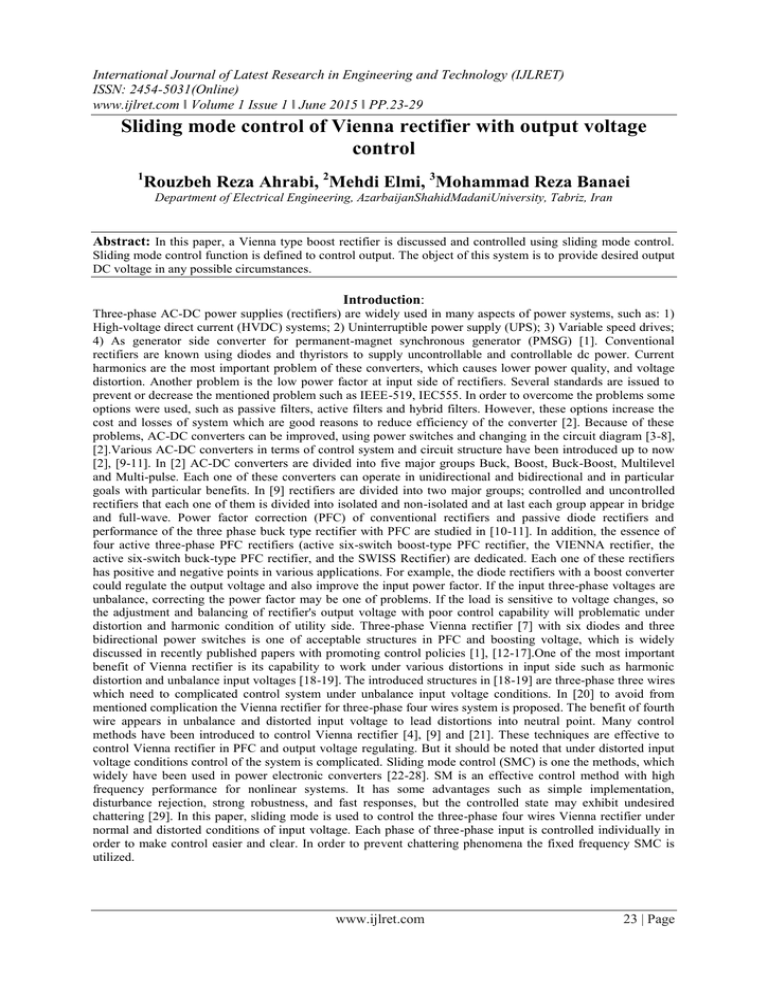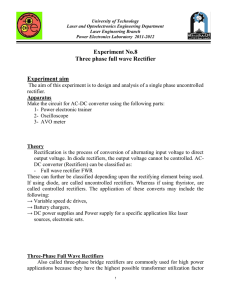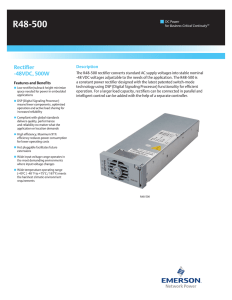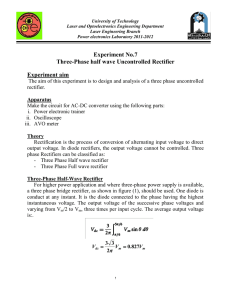Sliding mode control of Vienna rectifier with output voltage control
advertisement

International Journal of Latest Research in Engineering and Technology (IJLRET) ISSN: 2454-5031(Online) www.ijlret.com ǁ Volume 1 Issue 1 ǁ June 2015 ǁ PP.23-29 Sliding mode control of Vienna rectifier with output voltage control 1 Rouzbeh Reza Ahrabi, 2Mehdi Elmi, 3Mohammad Reza Banaei Department of Electrical Engineering, AzarbaijanShahidMadaniUniversity, Tabriz, Iran Abstract: In this paper, a Vienna type boost rectifier is discussed and controlled using sliding mode control. Sliding mode control function is defined to control output. The object of this system is to provide desired output DC voltage in any possible circumstances. Introduction: Three-phase AC-DC power supplies (rectifiers) are widely used in many aspects of power systems, such as: 1) High-voltage direct current (HVDC) systems; 2) Uninterruptible power supply (UPS); 3) Variable speed drives; 4) As generator side converter for permanent-magnet synchronous generator (PMSG) [1]. Conventional rectifiers are known using diodes and thyristors to supply uncontrollable and controllable dc power. Current harmonics are the most important problem of these converters, which causes lower power quality, and voltage distortion. Another problem is the low power factor at input side of rectifiers. Several standards are issued to prevent or decrease the mentioned problem such as IEEE-519, IEC555. In order to overcome the problems some options were used, such as passive filters, active filters and hybrid filters. However, these options increase the cost and losses of system which are good reasons to reduce efficiency of the converter [2]. Because of these problems, AC-DC converters can be improved, using power switches and changing in the circuit diagram [3-8], [2].Various AC-DC converters in terms of control system and circuit structure have been introduced up to now [2], [9-11]. In [2] AC-DC converters are divided into five major groups Buck, Boost, Buck-Boost, Multilevel and Multi-pulse. Each one of these converters can operate in unidirectional and bidirectional and in particular goals with particular benefits. In [9] rectifiers are divided into two major groups; controlled and uncontrolled rectifiers that each one of them is divided into isolated and non-isolated and at last each group appear in bridge and full-wave. Power factor correction (PFC) of conventional rectifiers and passive diode rectifiers and performance of the three phase buck type rectifier with PFC are studied in [10-11]. In addition, the essence of four active three-phase PFC rectifiers (active six-switch boost-type PFC rectifier, the VIENNA rectifier, the active six-switch buck-type PFC rectifier, and the SWISS Rectifier) are dedicated. Each one of these rectifiers has positive and negative points in various applications. For example, the diode rectifiers with a boost converter could regulate the output voltage and also improve the input power factor. If the input three-phase voltages are unbalance, correcting the power factor may be one of problems. If the load is sensitive to voltage changes, so the adjustment and balancing of rectifier's output voltage with poor control capability will problematic under distortion and harmonic condition of utility side. Three-phase Vienna rectifier [7] with six diodes and three bidirectional power switches is one of acceptable structures in PFC and boosting voltage, which is widely discussed in recently published papers with promoting control policies [1], [12-17].One of the most important benefit of Vienna rectifier is its capability to work under various distortions in input side such as harmonic distortion and unbalance input voltages [18-19]. The introduced structures in [18-19] are three-phase three wires which need to complicated control system under unbalance input voltage conditions. In [20] to avoid from mentioned complication the Vienna rectifier for three-phase four wires system is proposed. The benefit of fourth wire appears in unbalance and distorted input voltage to lead distortions into neutral point. Many control methods have been introduced to control Vienna rectifier [4], [9] and [21]. These techniques are effective to control Vienna rectifier in PFC and output voltage regulating. But it should be noted that under distorted input voltage conditions control of the system is complicated. Sliding mode control (SMC) is one the methods, which widely have been used in power electronic converters [22-28]. SM is an effective control method with high frequency performance for nonlinear systems. It has some advantages such as simple implementation, disturbance rejection, strong robustness, and fast responses, but the controlled state may exhibit undesired chattering [29]. In this paper, sliding mode is used to control the three-phase four wires Vienna rectifier under normal and distorted conditions of input voltage. Each phase of three-phase input is controlled individually in order to make control easier and clear. In order to prevent chattering phenomena the fixed frequency SMC is utilized. www.ijlret.com 23 | Page Sliding mode control of Vienna rectifier with output voltage control System configuration Three-phase three wires and four wires Vienna rectifiers are illustrated in Fig. 1(a) and Fig. 1(b) respectively. In this paper three-phase four wires Vienna rectifier is considered. In the normal condition VA, VB and VC are input three-phase voltage and each phase has 120° phase shift in comparison to other phases. La, Lb and Lc are input filter inductors. Sa, Sb and Sc are bidirectional power switches, insulated-gate bipolar transistor (IGBT) with common emitter connection for each double switches. Dau Dbu Dcu Cu Vo load Sa Sb Sc load Vn VA ia La VB ib Lb VC ic Lc Vo Cd Dad Dbd Dcd (a) Dau Dbu Dcu Vn VA ia La VB ib Lb VC ic Lc Sa Sb Sc Vn Cu Cd Dad Dbd Dcd (b) Fig. 1 a. Three-phase Vienna rectifier b. Three-phase Vienna rectifier with connected fourth wire Based on the presented structure in Fig. 1(b) the three phase system can be considered as 3 single phase system without loss of generality and exclusive feature of rectifier. Fig. 2 show single-phase structure of Vienna rectifier. Compensation scheme and control procedure will be executed on single-phase structure then it will be generalized to three-phase system. Lu Vin iin L Sg Ld Vn Cu load Vn Vo Cd Fig. 2 Single-phase Vienna rectifier Converter performance Vienna rectifier perform as boost AC-DC converter. In order to describe performance of the Vienna rectifier, single-phase structure of AC-DC converter is considered as Fig. 2. Performance of the Vienna rectifier is divided into two states which are shoot through and non-shoot through. www.ijlret.com 24 | Page Sliding mode control of Vienna rectifier with output voltage control Shoot through In this state without noticing to input voltage phase, power switch Sgis turned on and AC current flows through inductor L, power switch Sg and input voltage source. Fig. 3(a) shows shoot through state of Vienna rectifier, which bidirectional power switch is turned on and diodes Lu and Ld are reverse biased. Non-shoot through In this state power switchSgis turned off and diodes Lu and Ldare forward biased due to inductor current. Fig. 3(b) shows currents path in the non-shoot through. Lu Vn Ld Cu + _ Cd + _ Cu Vo load Vin iin load Vn + _ Sg L Vo (a) Lu Vn Sg Vin iin L Vn Ld + _ Cd (b) Fig. 3 a. Single-phase Vienna rectifier in shoot-through state b. Single-phase Vienna rectifier in non-shoot-through state Control scheme Control scheme is presented in order to combine with sliding mode control. Reference voltage is used by SMC to balance the capacitor’s voltage. Sliding mode control: Fig. 4 shows performance diagram of control system, which will merge with sliding mode in order to control the Vienna rectifier. vref + _ x1 vo Fig. 4 Diagram of control system The sliding surface, S,is defined as: www.ijlret.com 25 | Page Sliding mode control of Vienna rectifier with output voltage control S 1 x1 2 x2 3 x3 (4) That α1, α2 and α3 are the sliding surfaceindexes. The logic state of power switch Sgis defined as follows: 1 u (1 sign(S)) 2 (5) where, u is switching function. In order to control Vienna rectifier with PFC and output voltage balancing capabilities, the input current error x1, the output voltage error x2 and the integral of the voltage and current errors x3 are considered as control variables which are expressed as: iref K vref vo K vref vo (6) x i i 1 ref L x2 vref vo x3 x1 x2 dt (7) K is the gain of the voltage error. A large value for K is chosen to improve dynamic response and to minimize the steady state voltage errors [30]. Dynamic model of Vienna rectifier based on Fig. 2 can be obtained as follows: . d iref iL dv v uvo K o i x1 dt L dt . d vref vo dv o (8) x2 dt dt . x3 x1 x2 K vref vo iL vref vo u 1 u is considered to be complementary logic of u. vi and vo are instantaneous input and output voltages. L donates inductor of the converter. The equivalent control signal of the SM current controller when applied to the Vienna rectifier is obtained by solving (9). . . . dS 1 x1 2 x 2 3 x3 0 dt (9) which gives uvo vref vo L 3 K L 3 1 1 dvo 2 3 LK LiL vo vi dt 1 1 (10) where, 3 KL 3 1 1 K 2 LK 2 1 K3 3 L 1 K1 L (11) (12) (13) Considering vramp= uvo and replacing uvowithvr then we have dv vr K1 vref vo K 2 o K3iL vo vi dt vramp uvo www.ijlret.com (14) (15) 26 | Page Sliding mode control of Vienna rectifier with output voltage control Because of fixed-frequency structure of presented SM controller, the chattering phenomenon, which is the important drawbacks of nonlinear controllers, will be eliminated. Simulation result In order to verify performance of the proposed SMC on three-phase Vienna rectifier Matlab/Simulink is done. Simulations is operated in discrete mode with 1 µs step size. Parameters of Vienna rectifier are listed in Table I. k, orthogonal systems bandwidth factor is 0.3. In this case the input signal consist of main harmonic with 20% fifth harmonic, 5% seventh harmonic and 2% eleventh harmonic with 20.71% total harmonic distortion (THD). Main harmonic appear with peak voltage of 100 (V) and the frequency is 50 (Hz). Fig. 5(a) shows the distorted utility side voltage which supplies a Vienna rectifier and at 0.18 sec its fundamental component is increased up to 50%. The output DC voltage of Vienna rectifier is shown in Fig. 5(b). It can be seen from this figure that the output voltage remains constant in its reference value (500v) despite of input voltages changing. Table I Tested system parameters RLoad L Vi(peak) 150 (Ω) 1 (mH) 100 (V) 200 100 0 -100 -200 0.1 0.14 0.18 Time (s) 0.22 0.26 2.2 2.6 (a) 600 550 500 450 400 1 1.4 1.8 Time (s) (c) Fig. 8 Simulation results for three-phase grid connected Vienna rectifier with distorted input voltage ( Fundamental voltages are increased 50% at t = 0.18 s ) a. Grid side voltage b. Output DC voltage These results verify the proper performance of presented control system based on combination of SMC and orthogonal systems. Conclusion Sliding mode control is applied to Vienna rectifier. Output voltage is controlled and stabilized in desire voltage. Despite of input distortions,output DC voltage is stabled on desire voltage that guarantee the performance of control system. www.ijlret.com 27 | Page Sliding mode control of Vienna rectifier with output voltage control References [1]. [2]. [3]. [4]. [5]. [6]. [7]. [8]. [9]. [10]. [11]. [12]. [13]. [14]. [15]. [16]. [17]. [18]. [19]. [20]. [21]. Uzunoglu M, Kocatepe C, Yumurtaci R. Voltage stability analysis in the power systems including nonlinear loads. European Transactions on Telecommunications 2004; 14 : 41-56. DOI: 10.1002/etep.5 Rajaei A, Mohamadian M, YazdianVarjani A. Vienna-Rectifier-Based Direct Torque Control of PMSG for Wind Energy Application. IEEE Transactions on Industrial Electronics 2013; 60: 2919-2929. DOI: 10.1109/TIE.2012.2227905 Singh Bhim, Singh B.N, Chandra A, Al-Haddad K, Pandey A, Kothari D.P. A review of three-phase improved power quality AC-DC converters. IEEE Transactions on Industrial Electronics 2004; 51: 641660. DOI: 10.1109/TIE.2004.825341 Grbovic P.J, Delarue P, Le Moigne P. A Novel Three-Phase Diode Boost Rectifier Using Hybrid HalfDC-Bus-Voltage Rated Boost Converter. IEEE Transactions on Industrial Electronics 2011; 58: 13161329. DOI: 10.1109/TIE.2010.2050757 Kolar J.W, Ertl H, Zach F.C. Space vector-based analytical analysis of the input current distortion of a three-phase discontinuous-mode boost rectifier system. IEEE Transactions on Power Electronics 1995; 10: 733-745.DOI: 10.1109/63.471293 Mohan N, Rastogi M, Naik R. Analysis of a new power electronics interface with approximately sinusoidal 3-phase utility currents and a regulated DC output. IEEE Transactions on Power Delivery 1993; 8: 540-546. DOI: 10.1109/61.216857 Kolar J.W, Drofenik U, Zach Franz C. VIENNA rectifier II-a novel single-stage high-frequency isolated three-phase PWM rectifier system. IEEE Transactions on Industrial Electronics 1999; 46: 674-691. DOI: 10.1109/41.778214 Kanaan H, Al-Haddad K, Chaffai R, Duguay L, Fnaiech F. A new low-frequency state model of a threephase three-switch three-level fixed-frequency PWM rectifier. Telecommunications Energy Conference 2001; Twenty-Third International: 384-391 DOI: 10.1049/cp:20010626 Nishimoto M, Dixon Juan W, Kulkarni Ashok B, Ooi Boon-Teck. An Integrated Controlled-Current PWM Rectifier Chopper Link for Sliding Mode Position Control. IEEE Transactions on Industry Applications 1987; IA-23: 894-900. DOI: 10.1109/TIA.1987.4505000 Singh B, Gairola S, Singh B.N, Chandra A, Al-Haddad K. Multipulse AC–DC Converters for Improving Power Quality: A Review. IEEE Transactions on Power Electronics 2008; 23: 260-281. DOI: 10.1109/TPEL.2007.911880 Kolar J.W, Friedli T. The Essence of Three-Phase PFC Rectifier Systems—Part I. IEEE Transactions on Power Electronics 2013; 28: 176-198. DOI: 10.1109/TPEL.2012.2197867 Friedli T, Hartmann M, Kolar J.W. The Essence of Three-Phase PFC Rectifier Systems—Part II. IEEE Transactions on Power Electronics 2014; 29: 543-560. DOI: 10.1109/TPEL.2013.2258472 Ming Z, Lijun H, Wenxi Y, Zhengyu L, Tolbert L.M. A Novel Strategy for Three-Phase/Switch/Level (Vienna) Rectifier Under Severe Unbalanced Grids. IEEE Transactions on Industrial Electronics 2013; 60: 4243-4252. DOI: 10.1109/TIE.2012.2217721 HaoCh, David N, Aliprantis D.C. Analysis of Permanent-Magnet Synchronous Generator With Vienna Rectifier for Wind Energy Conversion System. IEEE Transactions on Sustainable Energy 2013; 4: 154163. DOI: 10.1109/TSTE.2012.2208660 Lijun H, Ming Z, Tolbert L.M, Zhengyu L. Digitized Feedforward Compensation Method for HighPower-Density Three-Phase Vienna PFC Converter. IEEE Transactions on Industrial Electronics 2013; 60: 1512-1519. DOI: 10.1109/TIE.2012.2222851 Cheng Wa, Meng H, Tse C.K, Siu-Chung W, Xinbo R. Nonlinear Behavior and Instability in a ThreePhase Boost Rectifier Connected to a Nonideal Power Grid With an Interacting Load. IEEE Transactions on Power Electronics 2013; 28: 3255-3265. DOI: 10.1109/TPEL.2012.2227505 Friedli T, Hartmann M, Kolar J.W. The Essence of Three-Phase PFC Rectifier Systems—Part II.IEEE Transactions on Power Electronics 2014; 29: 543-560. DOI: 10.1109/TPEL.2013.2258472 Liu S, Hang L, Zhang M. Natural frame-based strategy for vienna-type rectifier with light unbalanced input voltages. IET Power Electronics 2013; 6: 1427-1435. DOI: 10.1049/iet-pel.2012.0612 Lijun H, Bin L, Ming Z, Yong W, Tolbert L.M. Equivalence of SVM and Carrier-Based PWM in ThreePhase/Wire/Level Vienna Rectifier and Capability of Unbalanced-Load Control. IEEE Transactions on Industrial Electronics 2014; 61: 20-28 DOI: 10.1109/TIE.2013.2240637 Zhang X, Fan C. Research on 3-Phase 4-Wire VIENNA Rectifier Based on One Cycle Control. Intelligent Computation Technology and Automation (ICICTA) 2012; Fifth International Conference on:280-282. DOI: 10.1109/ICICTA.2012.77 Hartmann M, Miniboeck J, Kolar J.W. A Three-Phase Delta Switch Rectifier for More Electric Aircraft Applications Employing a Novel PWM Current Control Concept. Applied Power Electronics Conference and Exposition APEC 2009; Twenty-Fourth Annual IEEE: 1633-1640. DOI: 10.1109/APEC.2009.4802887 www.ijlret.com 28 | Page Sliding mode control of Vienna rectifier with output voltage control [22]. Sanchis P, Ursaea A, Gubia E, Marroyo L. Boost DC-AC inverter: a new control strategy. IEEE Transactions on Power Electronics 2005; 20: 343-353. DOI: 10.1109/TPEL.2004.843000 [23]. Pinheiro H, Martins A.S, Pinheiro J.R. A sliding mode controller in single phase voltage source inverters. Industrial Electronics Control and Instrumentation 1994; 1: 394-398. DOI: 10.1109/IECON.1994.397810 [24]. Oucheriah S, Liping G. PWM-Based Adaptive Sliding-Mode Control for Boost DC–DC Converters. IEEE Transactions on Industrial Electronics 2013; 60: 3291-3294. DOI: 10.1109/TIE.2012.220376 [25]. Shtessel Y, Baev S, Biglari H. Unity Power Factor Control in Three-Phase AC/DC Boost Converter Using Sliding Modes. IEEE Transactions on Industrial Electronics 2008; 55: 3874-3882. DOI: 10.1109/TIE.2008.2003203 [26]. Majid N, Mohammad Rasoul N, Taher N, Shahrokh J. Design of sliding mode controller for UPFC to improve power oscillation damping. Applied Soft Computing 2011; 11: 4766–4772. DOI: 10.1016/j.asoc.2011.07.006 [27]. Malesani L, Spiazzi R.G, Tenti P. Performance optimization of Cuk converters by sliding-mode control. IEEE Transactions on Power Electronics 1995; 10: 302-309. DOI: 10.1109/63.387995 [28]. Il-Song K. Robust maximum power point tracker using sliding mode controller for the three-phase gridconnected photovoltaic system. Solar Energy 2007; 81: 405-414. DOI: 10.1016/j.solener.2006.04.005 [29]. Jiabing H, Heng N, Bin H, Yikang H, Zhu Z.Q. Direct Active and Reactive Power Regulation of DFIG Using Sliding-Mode Control Approach. IEEE Transactions on Energy Conversion 2010; 25: 1028-1039. DOI: 10.1109/TEC.2010.2048754 [30]. Ciobotaru M, Teodorescu R, Blaabjerg F. A New Single-Phase PLL Structure Based on Second Order Generalized Integrator. Power Electronics Specialists Conference 2006; PESC '06: 18-22. DOI: 10.1109/PESC.2006.1711988 [31]. Fossas E, Martinez L, Ordinas J. Sliding mode control reduces audiosusceptibility and load perturbation in the Cuk converter. IEEE Transactions on Circuits and Systems I: Fundamental Theory and Applications 1992; 39: 847-849. DOI: 10.1109/81.199870 [32]. Martinez-Salamero L, Calvente J, Giral R, Poveda A, Fossas E. Analysis of a bidirectional coupledinductor Cuk converter operating in sliding mode. IEEE Transactions on Circuits and Systems I: Fundamental Theory and Applications 1998; 45: 355-363 DOI: 10.1109/81.669058 [33]. Siew-Chong Tan, Lai Y.M, Tse C.K.A unified approach to the design of PWM-based sliding-mode voltage controllers for basic DC-DC converters in continuous conduction mode. IEEE Transactions on Circuits and Systems I: Regular Papers 2006; 53: 1816-1827. DOI: 10.1109/TCSI.2006.879052 www.ijlret.com 29 | Page



